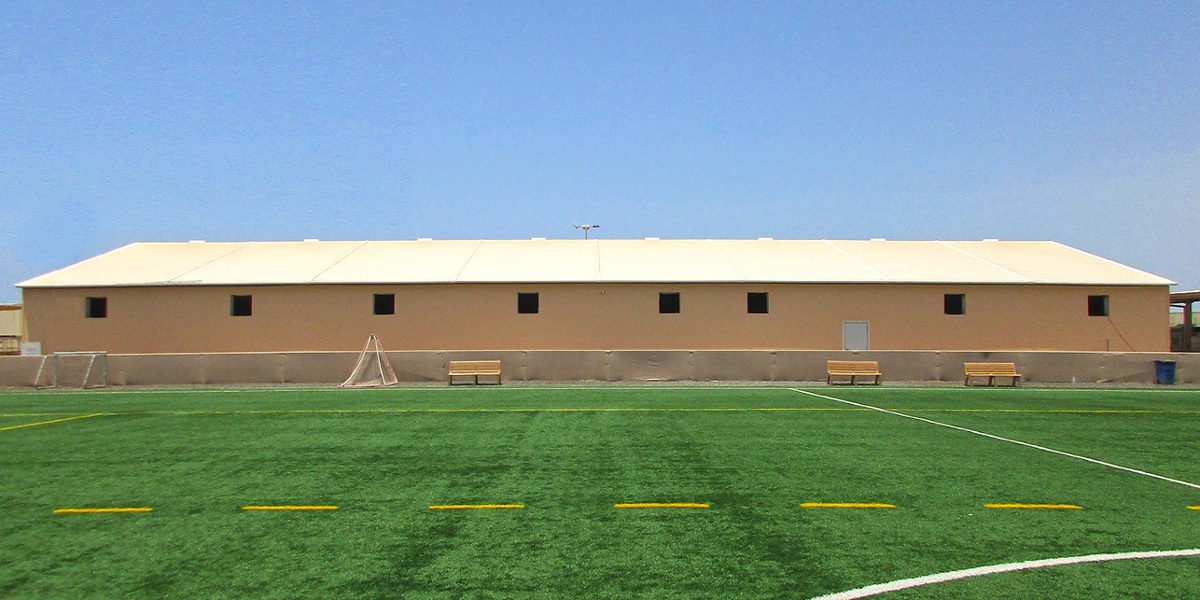Tension Fabric Structures 101

Welcome to class. If you’ve looked through the syllabus, you will already know we are going to investigate the ins and outs of Tension Fabric Structures. Your regular instructor would typically begin with a lecture about the history of fabric structures, starting with tents, but that’s why we are here to clarify his previous lecture. So let’s get to it, shall we?
Definition
The definition of the tension fabric structure, or TFS, is a building with fabric cladding stretched over a rigid frame. If you read the Wikipedia entry on tension fabric buildings, it will tell you that the fabric is stretched over the frame and the tension provides structural support for the building. That information is true, but it is a bit dated.
The new generation of tension fabric structures includes a rigid frame, as stated, but by building code the fabric cladding is not included in the calculation to provide support. These more recent entrants into the world of fabric buildings use solid rigid steel beams, like a traditional building, and can stand on their own without support from the fabric.
Tough Fabric
What does the fabric do then, you may ask? Good question. It makes up the wall and the roof cladding that keeps the weather out, in much the same way traditional walls and roofs do. It’s pretty simple.
If you are wondering if fabric walls are strong enough, remember that this is industrial fabric that has been used on buildings in climates and seismic areas all over the world. Most cladding for fabric buildings is either polyethylene (PL) or polyvinyl chloride (PVC).
In some cases, the fabric in a TFS is all in one piece stretched over the frame. These applications leave the building fabric vulnerable because it acts like a very large sail attached at each end of the building. Other applications use individual fabric panels stretched between the support beams. To test the strength of their panels and fabric attachment system, one company, Legacy Building Solutions, even drove a skid loader on one of their suspended panels. With individual panels, if damage occurs, the panel is more easily replaced at a fraction of the cost of replacing the entire cladding skin.
Industries
This is an exciting time for the TFS industry. More and more industries are finding that the TFS meets their building needs including:
- Bulk Storage
- Entertainment venues
- Aviation
- Military
- Equestrian
- Agriculture
- Sports complexes
- Mining
- Oil, gas and energy alternatives
- Salt sheds
Some of these applications are open-air, roof-only buildings, but others are completely enclosed with insulation, heating and cooling, and all the features you would expect from a traditional building. You might be asking: why choose a tension fabric structure in the first place? TFS tend to be much easier to maintain than a steel building. They can also be constructed much more quickly. Some assume these are just temporary structures because of the fabric, but that’s usually not the case.
The advances made in tension fabric structures continue to extend the reach of this construction alternative. Applications of this technology are only limited by the imagination. Eventually people will understand that many of the things that you can do with a traditional building, you can also do with a tension fabric structure.
In our next class we will be answering the question: Are all tension fabric buildings the same?
Frequently Asked Questions
A tension fabric structure (TFS) is a building with fabric cladding stretched over a rigid steel frame. Unlike earlier generations, today’s TFS rely on the rigid frame for structural support, not the fabric itself. The fabric serves as the roof and wall covering, protecting the interior from weather while allowing design flexibility.
TFS use industrial-grade fabric such as polyethylene (PE) or polyvinyl chloride (PVC). These materials are durable enough for use in harsh climates and seismic regions worldwide. Some systems use individual fabric panels instead of one large sheet, making them more resistant to damage and easier to repair or replace.
Tension fabric structures are versatile and used in a wide range of industries, including:
-
Bulk storage
-
Sports complexes and entertainment venues
-
Military and aviation
-
Agriculture and equestrian facilities
-
Mining, oil, gas, and energy
-
Salt and commodity storage
They can be designed as open-air roof-only systems or fully enclosed, insulated facilities with heating, cooling, and modern building features.
Although some assume they are temporary, most modern tension fabric structures are permanent buildings. They are engineered to meet building codes, withstand extreme weather, and provide long-term, low-maintenance performance similar to traditional steel or wood buildings.
TFS offer several advantages over conventional buildings:
-
Faster construction timelines
-
Lower maintenance requirements
-
Design flexibility with clearspan interiors
-
Durability in extreme climates
-
Customizable features like insulation, lighting, and HVAC
They provide the same usability as traditional buildings with added efficiency and cost-effectiveness.
Subscribe to our Blog
Recent Posts
- 5 Factors Every Project Owner Should Consider Before Approving Building Materials
- The 20-Year View: How Material Choices Impact Long-Term Operational Costs
- Climate Resilience in Commercial Construction: Why Traditional Methods May Not Be Enough
- Speed and Quality: The Role of Hybrid Building Materials
- Beyond the Bleachers: Designing Visually Striking Sports Facilities

